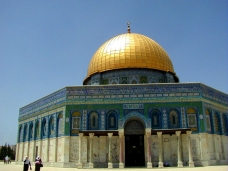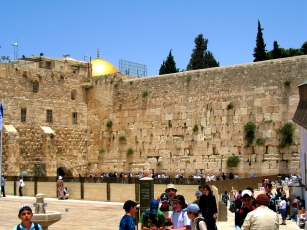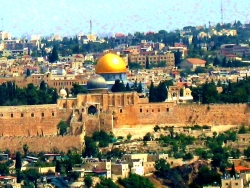A visit to peace activists in Palestine and Israel
In May and June of 2007, Eunice and Edward Ordman visited Israel
and the West Bank of
Palestine with a delegation from Interfaith Peace Builders.
This
group is a spin-off of the Fellowship
of Reconciliation and the trip
was also sponsored by The American Friends
Service Committee.
The following sections were prepared for potential use in talks we
might give about this trip. That is, this is not a connected talk and a
given talk would not include all this material. Following the
introduction, it is divided into separate web pages for ease in editing
and loading.
Disclaimer: I'm not an authority on these matters,
don't claim to be, and I'm deliberately over-simplifying in many
places. I don't have the patience to write a book on the subject,
and see no hope of tracking back problems to the original time when X
started the dispute with Y, probably by unexpectedly hitting Y back.
I'm happy to get e-mails of
modest length with further details and corrections.
PAGE 1: Introduction
Van Jones, in a talk in Memphis in January
of 2007 at a Media Reform
Conference, pointed out that in one of Martin Luther King’s famous
talks, he did not say, “I have a list of grievances”, he did not say “I
have a list of problems”, he did not say, “I have a list of
disagreements.” The object here is not to enumerate
troubles, it is to work towards the dream of peace.
Eboo Patel, a moderate Muslim
activist speaking in Memphis September 5, 2007, pointed out that the
principal religions, in the values they espouse and how they tell us to
act, have much more in common than they have differences. He urges
people to start talking about values they have in common, and acting on
the things they find in common - start with the small things, he says,
don’t start with the hard issues like Palestine and Israel.
Rabbi Meir Feldman, who is spending a
few years as Associate Rabbi at Temple
Israel in Memphis, pointed out that there were people
talking about a Jewish State in 1900. Some had no idea that this would
be a reality as soon as 50 years later. Of course, some didn't imagine
it could take as long as fifty years. He went on to say that we don’t
know how long it will take to have Jews and Muslims and Christians and
others living together in peace and security and prosperity in the
Middle East, but we need to start today even if it may take 50 years or
more.
In the Talmud, a major Jewish source
book, one of the Rabbis says, “The work is not ours to finish, but
neither are we free to take no part in it.”
I want to talk about peace, and how we
make peace. And I want to talk about things we did in Israel and
Palestine in May and June of this year 2007, and people we talked to.
And it is hard to do that without talking about grievances, about
problems, about disagreements. We described a big part of what we did
as -listening-. We wanted to
hear both sides, we wanted to hear moderates, we wanted to hear the
people whose voices don’t get into the papers or onto the TV news. So
some of what I report will be what people told us they believe, without
my having checked carefully to see if what they believe is in accord
with what other people believe. I'm not a writer of the calibre
of Studs Terkel or Amos Oz; you might enjoy reading Oz's book "In
the Land of Israel" in which he visits people and reports on what they
said.
A lot of people - good people - don't get heard,
and don't get press coverage. As one Palestinian I'll tell you
about said to us, "the TV people came and talked to me once. I talked
about reconciliation, about talking to one another, about nonviolent
settlements. They told me I wasn't sexy, I wasn't radical enough."
 We made our headquarters in
Jerusalem, and did see a few of the
standard sites. Here is the Dome of the Rock on the
Temple Mount.
We made our headquarters in
Jerusalem, and did see a few of the
standard sites. Here is the Dome of the Rock on the
Temple Mount.
You may recall that this is part of the Old City of Jerusalem,
holy to all of the Abrahamic faiths, and was in the area occupied by
Jordan until 1967 and occupied by Israel since the 1967 war. As
in many other parts of the area, one question is access: most Jews were
denied access to these sites between 1948 and 1967, and feel very
acutely about that. But the acuteness of this feeling plays
itself out in a variety of ways.
(I'm trying to rig these pages so that pictures with a colored border
can be enlarged by clicking on them. In progress.)

After Jordan
joined the war against Israel in 1967, Israel captured the Old City,
and Jews thronged to the Western Wall, a surviving piece of foundation
of the Second Temple probably dating to the time of Herod. Jews rapidly
moved back into the "Jewish Quarter" of the old city, the area near the
wall from which they had been expelled in 1948.
 In
capturing the Old City, Israel also captured the Temple Mount -
the site of the Dome of the Rock and of the El Aqsa Mosque, one of the
holiest sites for Muslims.
In
capturing the Old City, Israel also captured the Temple Mount -
the site of the Dome of the Rock and of the El Aqsa Mosque, one of the
holiest sites for Muslims.
The
security restrictions by Israel in recent years now make it
increasingly hard for many Muslim and Christian residents of the West
Bank to visit the holy places here. On the other hand, the
El Aqsa Mosque just south of the Dome remains the center of worship for
the Muslims who live within the Jerusalem city limits and those who are
able to travel there, and Israel does not prevent large religious
gatherings at the Mosque. In September 2007, at the start of
Ramadan, Israel did restrict travel from the West Bank to Jerusalem,
not admitting some Muslims who wanted to go pray in Jerusalem, and
there was considerable difficulty at some of the crossing points,
especially between Bethlehem and Jerusalem.
Ordman Net Home
What's next?
From here you can go on to other sections of
material.
CONTENTS:
Page 1: Introduction
Next> Page 2: Kfar Shalem
Page 3: Duheisha Refugee Camp
Page 4: Universities
Page 5: The Wall / Security Barrier
Page 6: Bethlehem
Page 7: Efrat
Page 8: Hebron
(More
to come)
 We made our headquarters in
Jerusalem, and did see a few of the
standard sites. Here is the Dome of the Rock on the
Temple Mount.
We made our headquarters in
Jerusalem, and did see a few of the
standard sites. Here is the Dome of the Rock on the
Temple Mount. 
 In
capturing the Old City, Israel also captured the Temple Mount -
the site of the Dome of the Rock and of the El Aqsa Mosque, one of the
holiest sites for Muslims.
In
capturing the Old City, Israel also captured the Temple Mount -
the site of the Dome of the Rock and of the El Aqsa Mosque, one of the
holiest sites for Muslims.